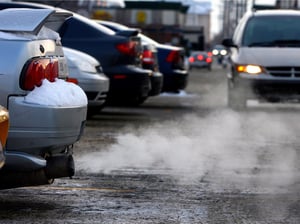It's your turn, to turn it off.
As temperatures continue to drop below freezing it’s pretty easy and convenient to let your vehicle idle until it warms up. Simply defined, idling is when a vehicle remains running without actually being in motion. Many of us in certain generations were taught, in fact, that when it’s cold it’s safer to let your car idle before driving it to ensure the engine was adequately “warm.” We’ve all done it, it’s easy to do, but if you’re going to be waiting more than 10 seconds, you can make a big difference by turning off your car.
You can save money, save gas, save health, and help save the planet. Modern car engines have actually been redesigned to get rid of the previous warm up time we’ve all become accustomed to, and now you can actually cause more harm to your car by idling. Reducing idle time also reduces the emission of greenhouse gases from tailpipes – including but not limited to CO2, carbon monoxide, sulfur dioxide, and nitrogen oxide – that are all linked to climate change and some pretty serious health conditions.
C urrently, nearly 30% of Eagle County carbon emissions comes from transportation and passenger vehicles. The Eagle County Climate Action Collaborative is committed to decreasing emissions 25% by 2025 and 80% by 2050, and they need your help to accomplish these goals. The bottom line: the more fuel you use, the more CO2 you produce. One easy way to cut your fuel consumption, save money and reduce emissions is to avoid unnecessary idling. After all, it gets you nowhere.
urrently, nearly 30% of Eagle County carbon emissions comes from transportation and passenger vehicles. The Eagle County Climate Action Collaborative is committed to decreasing emissions 25% by 2025 and 80% by 2050, and they need your help to accomplish these goals. The bottom line: the more fuel you use, the more CO2 you produce. One easy way to cut your fuel consumption, save money and reduce emissions is to avoid unnecessary idling. After all, it gets you nowhere.
Idling for just five minutes per day can produce over 25 pounds of pollutants, and 260 pounds of CO2 a year! This equates to consuming 1-2 tanks of fuel a year, which can add up to $35-$115 a year, depending on fuel prices, tank size, idling habits and vehicle type (Engine Off! Colorado).
According to Idle Free California, idling your engine for more than 10 seconds uses more fuel and emits more CO2 than restarting your engine. Idling longer than 30 seconds can start to damage your engine as carbon soot builds up, motor oil breaks down, and starters and batteries get excessive wear.
The idling times we have the greatest opportunity to change are when we first start up our vehicle, when we’re waiting in the pick-up/drop-off line at school, just running inside to get a ‘quick’ cup of coffee, or sitting outside a friend’s house, the post office or a business.
Here’s what you can do to help:
 1. Use a windshield cover overnight or face your windshield towards the morning sun, if possible, which will reduce the need to defrost. Warm up your vehicle by driving, not idling; it’ll warm up faster and cause less wear and tear on your engine.
1. Use a windshield cover overnight or face your windshield towards the morning sun, if possible, which will reduce the need to defrost. Warm up your vehicle by driving, not idling; it’ll warm up faster and cause less wear and tear on your engine.
2. You can also wear gloves and warmer clothes to be more comfortable in your car until it warms up while driving.
3. Have all your items ready to go in the morning so that you are reducing the amount of time your car is idling. You can turn your engine off at the post office, in the pick-up/drop-off line at school, or at businesses when you’re waiting for others or just popping in.
By making a conscious effort to reduce your idle time a couple minutes each day you will help us to reduce the emission of greenhouse gases and have a huge impact.
Living in such a small mountain town, where our economy relies on snowfall and outdoor recreation, it’s really important to preserve our fragile ecosystem and save this beautiful place we call home. Help us #BeBetterTogether to meet our Climate Action Collaborative goals to reduce Eagle County emissions 25% by 2025 and 80% by 2050.






